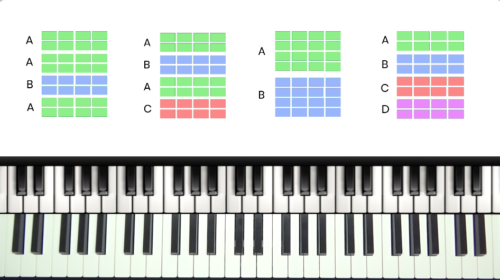“The Days Of Wine & Roses” Tutorial
“The Days Of Wine & Roses” is written in the key of F Major and follows and A-B-A-C form.
We start by playing through with some simple voicings. Pay attention to the chord changes and identify the common progressions such as 25s and 251s. This will help you memorise the tune, and also prepare you for the improvisation studies for this jazz standard.
Playing With A Rubato Feel
For this arrangement, we will be playing in a rubato fashion so you will hear that I stretch the bar lines in places to achieve this effect. We will be applying and demonstrating lots of important jazz theory such as upper structure triads, and we’ll also introduce interesting applications of drop 2 harmony.
Related Lessons – Block Chords & Drop 2 Harmony
The introduction lessons on block chords are an important area of study. Check out the tutorials on the “4 Way Close” and also “Drop 2 Voicings”. This will give you the theoretical understanding to apply these voicing techniques to the tunes that you are playing.
Practice Tips
-
This is an advanced ballad arrangement which includes some challenging theory in places.
-
In the next tutorial on this tune we will create a faster swinging arrangement and improvisation study.
-
As an exercise, learn the form with left hand voicings.
-
Practice with the iRealPro App at a medium tempo.
-
You need to have the voicings and the chord changes completely memorised and internalised before attempting to improvise over the tune.





Looking forward to the next lesson on this song using left hand voicings and a little improv. Thank you Hayden.
Hey Lori 👋
Yes sure thing, we actually have a few improv tutorials that need recording… ballad style improv for “Body and Soul” + “I Fall In Love Too Easily” and then uptempo for “Satin Doll”. I’ll get these done with or soon after the new website launch…. they will be a nice addition to the improv course. Cheers, Hayden
You’ll be proud, I worked it out and got the left hand voicings down and set in my head/hands on my own.
That’s great to hear Lori… keep practicing them until you can play them with your eyes closed or whilst not looking directly at your left hand. Once the left hand voicings are completely internalised and you don’t need to think about what’s coming next, then you’re ready to explore the tune with right hand improv. I was transcribing some material over this tune not long ago so I have some nice things to share… I’ll get started on it this week along with the others mentioned below. Cheers 🙂 Hayden
Hayden, In bars 19 and 20 I am trying to understand the subs of D13sus for A-7 and Dflat9#11 for D7. Could you explain please. Best and thanks!
Hi Vincent,
Good question.
Firstly the Db9#11 was a typo, it should be D7(b9#11) – the “7” missing. I have corrected the PDF download and re-uploaded it.
Regarding the sus chord, we can do this with any 25 or 251 progression.
D13sus is simply an A-9 chord, but with a D in the bass instead of A in the bass. The Sus chord can be seen as a “half way point” between the 2 and the 5 chord. When playing a 25 or 251 progression, we have the following options:
For more information on this, check out the following lessons and seminars where this is explained in detail with examples:
https://www.pianogroove.com/jazz-piano-lessons/how-to-play-sus-chords/ https://www.pianogroove.com/live-seminars/sus-chord-for-beginners/ https://www.pianogroove.com/live-seminars/how-to-play-like-beegie-adair/
After watching those lessons and seminars, all should be clear, but let me know if you have any further questions.
Cheers, Hayden